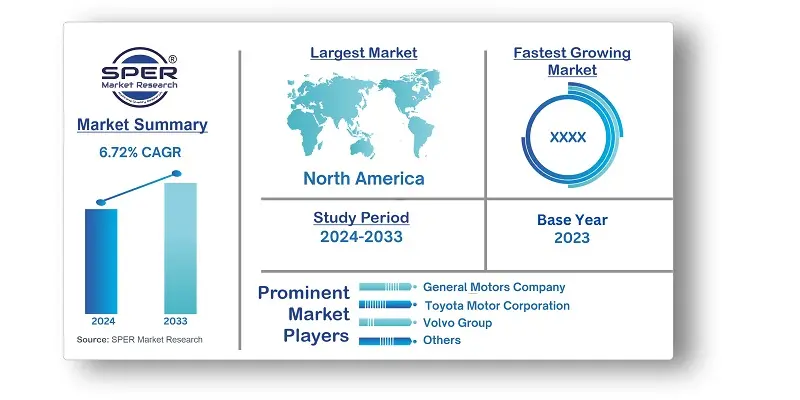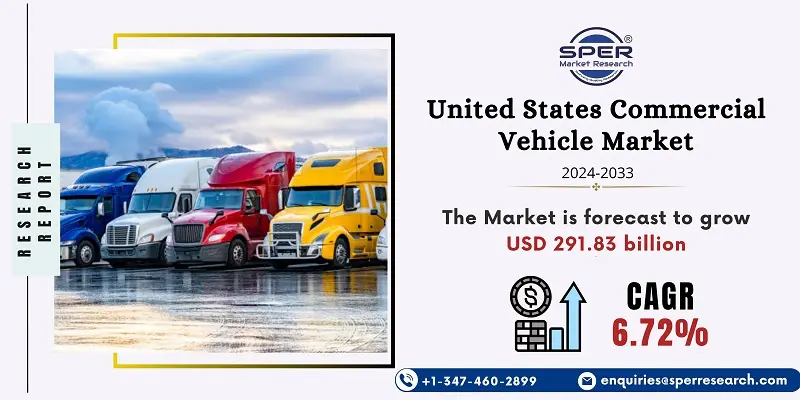
United States Commercial Vehicle Market Trends, Share, Demand, Revenue and Future Outlook
United States Commercial Vehicle Market Growth, Size, Trends Analysis- By Vehicle Type, By Propulsion Type- Regional Outlook, Competitive Strategies and Segment Forecast to 2033
| Published: Nov-2024 | Report ID: AMIN24244 | Pages: 1 - 109 | Formats*: |
| Category : Automotive & Transportation | |||
- The brand-new MPV Vellfire strong hybrid electric vehicle (SHEV) was introduced by Toyota Kirloskar Motor in August 2023. Its beginning price was INR 11.99 million and would eventually go up to INR 12.99 million.
- General Motors intensifies its ambitions for an electric future in the Middle East in August 2023.


| Report Metric | Details |
| Market size available for years | 2020-2033 |
| Base year considered | 2023 |
| Forecast period | 2024-2033 |
| Segments covered | By Vehicle Type, By Propulsion Type |
| Regions covered | Eastern region, Western region, Southern region, Northern region |
| Companies Covered | Daimler AG (Mercedes-Benz AG), Daimler Truck Holding AG, Ford Motor Company, General Motors Company, Hino Motors Ltd., Isuzu Motors Limited, PACCAR Inc., Ram Trucking, Inc., Toyota Motor Corporation, Volvo Group, Others. |
- Fleet Operators
- Logistics and Transportation Companies
- Government and Public Sector
- E-commerce and Retail Businesses
- Construction and Mining Companies
- Agriculture and Farming Sector
- Automotive OEMs and Suppliers
- Vehicle Leasing and Rental Companies
| By Vehicle Type: | |
| By Propulsion Type: |
- United States Commercial Vehicle Market Size (FY’2024-FY’2033)
- Overview of United States Commercial Vehicle Market
- Segmentation of United States Commercial Vehicle Market By Vehicle Type (Light Commercial Vehicles, Medium Commercial Vehicles, Heavy Commercial Vehicles)
- Segmentation of United States Commercial Vehicle Market By Propulsion Type (ICE, BEV, Hybrids, FCEVs)
- Expansion Analysis of United States Commercial Vehicle Market
- Problems and Obstacles in United States Commercial Vehicle Market
- Competitive Landscape in the United States Commercial Vehicle Market
- Impact of COVID-19 and Demonetization on United States Commercial Vehicle Market
- Details on Current Investment in United States Commercial Vehicle Market
- Competitive Analysis of United States Commercial Vehicle Market
- Prominent Players in the United States Commercial Vehicle Market
- SWOT Analysis of United States Commercial Vehicle Market
- United States Commercial Vehicle Market Future Outlook and Projections (FY’2024-FY’2033)
- Recommendations from Analyst
1.1. Scope of the report1.2. Market segment analysis
2.1. Research data source2.1.1. Secondary Data2.1.2. Primary Data2.1.3. SPER’s internal database2.1.4. Premium insight from KOL’s2.2. Market size estimation2.2.1. Top-down and Bottom-up approach2.3. Data triangulation
4.1. Driver, Restraint, Opportunity and Challenges analysis4.1.1. Drivers4.1.2. Restraints4.1.3. Opportunities4.1.4. Challenges4.2. COVID-19 Impacts of the United States Commercial Vehicle Market
5.1. SWOT Analysis5.1.1. Strengths5.1.2. Weaknesses5.1.3. Opportunities5.1.4. Threats5.2. PESTEL Analysis5.2.1. Political Landscape5.2.2. Economic Landscape5.2.3. Social Landscape5.2.4. Technological Landscape5.2.5. Environmental Landscape5.2.6. Legal Landscape5.3. PORTER’s Five Forces5.3.1. Bargaining power of suppliers5.3.2. Bargaining power of buyers5.3.3. Threat of Substitute5.3.4. Threat of new entrant5.3.5. Competitive rivalry5.4. Heat Map Analysis
6.1. United States Commercial Vehicle Market Manufacturing Base Distribution, Sales Area, Product Type6.2. Mergers & Acquisitions, Partnerships, Product Launch, and Collaboration in United States Commercial Vehicle Market
7.1. United States Commercial Vehicle Market Size, Share and Forecast, By Vehicle Type, 2020-20267.2. United States Commercial Vehicle Market Size, Share and Forecast, By Vehicle Type, 2027-20337.3. Light Commercial Vehicles7.4. Medium Commercial Vehicles7.5. Heavy Commercial Vehicles
8.1. United States Commercial Vehicle Market Size, Share and Forecast, By Propulsion Type, 2020-20268.2. United States Commercial Vehicle Market Size, Share and Forecast, By Propulsion Type, 2027-20338.3. ICE8.4. BEV8.5. Hybrids8.6. FCEVs
9.1. United States Commercial Vehicle Market Size and Market Share
10.1. United States Commercial Vehicle Market Size and Market Share By Region (2020-2026)10.2. United States Commercial Vehicle Market Size and Market Share By Region (2027-2033)10.3. Eastern Region10.4. Western Region10.5. Southern Region10.6. Northern Region
11.1. Daimler AG (Mercedes-Benz AG)11.1.1. Company details11.1.2. Financial outlook11.1.3. Product summary11.1.4. Recent developments11.2. Daimler Truck Holding AG11.2.1. Company details11.2.2. Financial outlook11.2.3. Product summary11.2.4. Recent developments11.3. Ford Motor Company11.3.1. Company details11.3.2. Financial outlook11.3.3. Product summary11.3.4. Recent developments11.4. General Motors Company11.4.1. Company details11.4.2. Financial outlook11.4.3. Product summary11.4.4. Recent developments11.5. Hino Motors Ltd.11.5.1. Company details11.5.2. Financial outlook11.5.3. Product summary11.5.4. Recent developments11.6. Isuzu Motors Limited11.6.1. Company details11.6.2. Financial outlook11.6.3. Product summary11.6.4. Recent developments11.7. PACCAR Inc.11.7.1. Company details11.7.2. Financial outlook11.7.3. Product summary11.7.4. Recent developments11.8. Ram Trucking, Inc.11.8.1. Company details11.8.2. Financial outlook11.8.3. Product summary11.8.4. Recent developments11.9. Toyota Motor Corporation11.9.1. Company details11.9.2. Financial outlook11.9.3. Product summary11.9.4. Recent developments11.10. Volvo Group11.10.1. Company details11.10.2. Financial outlook11.10.3. Product summary11.10.4. Recent developments11.11. Others
SPER Market Research’s methodology uses great emphasis on primary research to ensure that the market intelligence insights are up to date, reliable and accurate. Primary interviews are done with players involved in each phase of a supply chain to analyze the market forecasting. The secondary research method is used to help you fully understand how the future markets and the spending patterns look likes.
The report is based on in-depth qualitative and quantitative analysis of the Product Market. The quantitative analysis involves the application of various projection and sampling techniques. The qualitative analysis involves primary interviews, surveys, and vendor briefings. The data gathered as a result of these processes are validated through experts opinion. Our research methodology entails an ideal mixture of primary and secondary initiatives.



Frequently Asked Questions About This Report
PLACE AN ORDER
Year End Discount
Sample Report
Pre-Purchase Inquiry
NEED CUSTOMIZATION?
Request CustomizationCALL OR EMAIL US
100% Secure Payment






Related Reports
Our Global Clients
Our data-driven insights have influenced the strategy of 200+ reputed companies across the globe.




















